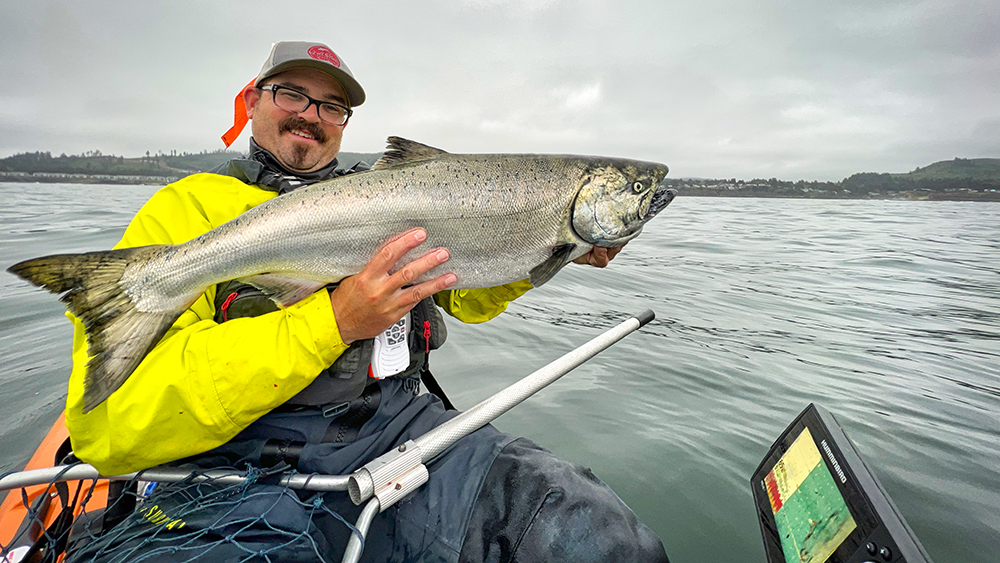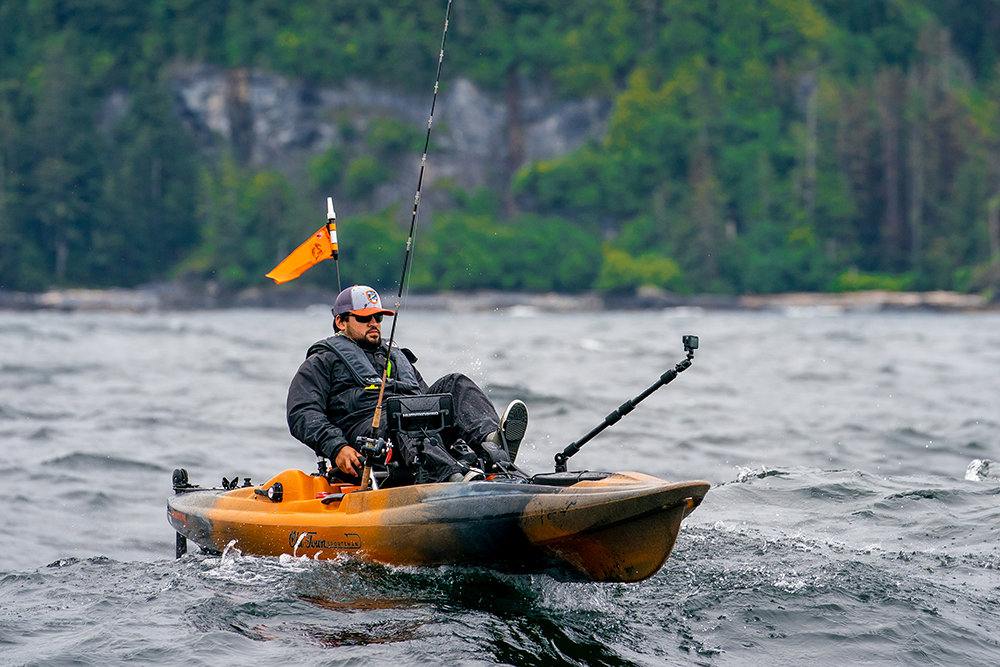Offshore Kayak Safety
By: Tyler Hicks, Ambassador
Seventy percent of Earth’s surface is covered in oceans. It would seem a waste to not kayak it. Venturing out onto the big blue in a kayak can be an exhilarating adventure. Whether you are an angler seeking to harvest the bounty of the sea or a recreational paddler looking to enjoy the diversity of sea life and seascapes our coasts have to offer you need to take certain precautions to ensure a safe journey. With the right equipment, preparations, and skills every kayak trip out onto our oceans can be a safe one.
Before you head out, be sure to download the Pre-Trip Safety Checklist as you prepare for your next trip.
Essential Safety Equipment & Skills
Personal Floatation Device: According to the Coast Guard approximately 75% of kayak drowning victims were not wearing a personal floatation device. Wear one.
Cold Water Immersion Gear: Not all offshore kayakers need to worry about cold water immersion. However, cold water and hypothermia are real dangers off our northern coasts. A good rule to follow is the 120 rule. If air and water temperature (in Fahrenheit) do not add up to more than 120 you should have some sort of immersion gear. Lightweight breathable dry suits or a paddling jacket with a skirt or dry pants are best.
Self Rescue Skills: When you are multiple miles out to sea swimming the kayak back to shore really isn’t an option. Practice flipping your kayak back to the upright position and getting back into it until it becomes second nature.
Bilge Pump: In the event you flip your kayak or get caught in rough wind waves you may get some water penetration inside your full. A small plastic bilge hand pump can make quick work of removing water from inside your hull restoring stability and speed.
Handheld Floating VHF Radio: Compact rechargeable floating VHF radios are a must-have for offshore kayak adventures. VHF provides an easy way to contact other vessels on the water in the event you need assistance or information. Additionally, Coast Guard can be reached on channel 16 and most vessels monitor channel 16 as well and can offer assistance in the event of an emergency.
Visibility, Flags, and Lights: Due to the size of kayaks, the vastness of the ocean, and ocean swell kayakers can very easily disappear. Increase your visibility by selecting brightly colored kayaks, wearing bright clothing, flying high-viz flags, and in low-light situations running a 360-degree white light. You may even opt to carry small handheld flares to use in the event of an emergency.
Auditory Devices: While it's always good practice to carry a whistle in your PFD pocket I suggest adding a small klaxon or air horn to your kit. The sound of a whistle doesn’t carry as far as a klaxon will, especially in foggy and rough conditions.
Repair Kit: For those using Old Town’s PDL or motorized kayaks, having a box of spare parts and tools is always a good idea for on-the-water repair. A spare prop, shear pins, washers and nuts, and replacement knobs are all good items to have on hand as well as the tools needed to complete the job. Don’t forget to throw in some heavy-duty duct tape and zip ties you never know when you might need to express your inner McGyver to get back to shore safely.
Cell Phone: Thanks in large part to the open expanses of the ocean, cell phone reception is often good offshore. Many modern smartphones are now fully waterproof and if yours isn’t inexpensive waterproof housings that allow for use of touch screens through plastic are widely available. Not only do smartphones allow for quick contact of help in the event of an emergency but can provide real-time access to weather radar and tides data.
Personal Locator Beacon (optional): PLBs have become increasingly smaller and more affordable. Depending on the manufacturer and model you may need to pay for a subscription plan whereas others do not require one. Either way with the push or flip of a button the authorities will be notified immediately of your exact GPS location. Most PLBs are small enough to carry in the pocket of your PFD and some can be linked with your smartphone to send text messages from anywhere on planet Earth.

Pre-launch Safety Checks
Weather and Ocean Forecasts: Nothing is more important than understanding weather and ocean forecasts when planning an offshore trip. The ocean offers no protection from the elements and conditions can change rapidly. Winds under 10 mph are best and you generally want to avoid being out in anything over 15 mph. Even relatively light winds can lead to building seas if the winds oppose the primary swell direction. In some regions thunderstorms are a potential threat to avoid and anglers should pay close attention to radar and building storms on the horizon as lightning represents a significant threat to any kayak angler on the water.
Wave height and swell period are additional factors you have to consider especially on the east and west coasts of North America. Marine forecasts include two important pieces of information. The first is wave height. Wave height is the distance from the bottom or trough of the wave to the top or crest of the next wave. Waves heights greater than 4’ start to become uncomfortable for most kayakers but will vary by individual tolerance and experience on the ocean. While wave height plays a critical role in ocean conditions ‘swell period’ or the time between the crest of one wave passing a stationary point until the next passes is just as important. The longer the period the flatter a wave will feel to the kayaker. A good rule of thumb for comfort is that the period should be at least twice as long as the wave height. Otherwise, waves become tightly packed together and steep and it will feel more like kayaking in a washing machine. In some regions, especially the West Coast, there will often be a primary swell and secondary and even tertiary swells. These multiple swells are generated by storms far away. Mixed swells of similar height and period can lead to “confused” or sloppy seas and uncomfortable conditions. Additionally, primary and secondary swells coming from similar directions can lead to the occasional building of wave heights. These synergistic waves are often reported as “significant wave height” and represent the average height of the highest 1/3rd of waves and can be significantly higher than the primary swell wave height.
Additionally, wind wave heights are reported separately from swell height. Wind waves are generated locally and are generally short in period and thus steeper than swell. Wind waves are waves that will be breaking and can impede kayak movement or even cause kayaks to flip. Wind waves of less than 2’ are best for kayaking and anything over 3’ requires expertise in kayak maneuvering, balance, and, in paddle and pedal kayaks, physical endurance. Wind waves will tend to build more when winds oppose the primary swell direction.

Tides: Depending on where you plan to fish tides may or may not be of concern to your safety. If launching or landing on flats, a low tide can leave you far from the water or stranded far from your launch location. Tides will also interact with swell and wind and when in opposition to either can cause seas to build. Lastly, tides can result in a strong current, especially when moving thru inlets that are draining bays or sounds. In areas with large tidal swings currents of 2 or 3+ mph are not uncommon and kayakers should plan accordingly. Many kayakers will plan trips to paddle out with the outgoing tide and return on the flood tide. However, there are many factors that will play a role in planning around tides including the size of the tidal swing and how the tide may interact with local geography, wind, and swell conditions.
Float Plans: Everyone whether fishing alone or with others should file a float plan with a loved one or someone they trust. A float plan is an insurance policy in the event that you get into trouble and are unable to self-rescue or coordinate rescue yourself.
What to include in your float plan:
- Name
- Kayak description (color, length, model)
- Launch location
- Launch vehicle description and license plate
- Launch date and time
- Anticipated travel route or fishing grounds
- Safety equipment on board (e.g. PFD, flares, whistle, klaxon, VHF, immersion gear)
- Anticipated landing time
- Check-in time and date
- Cell phone #
The most important thing is to not discourage whomever you file your float plan with to contact the authorities should you fail to check-in. Equally important is that you ensure that you don’t push past your check-in time. Commit to being off the water when you said you would or at least update your contact if you decide to stay out longer.

Kayak Inspection: Modern kayaks, especially pedal and motorized kayaks have many moving parts. Prior to launch, inspect your kayak for any potential mechanical issues. This includes rudder deploy/lift and steering, pedal drives and motors, and any other accessories that may be critical to your safety on the water, especially GPS-enabled fish finders.
Post-Landing Maintenance
Freshwater Rinse: After any adventure on the salt it's an especially good idea to rinse your kayak, especially those with pedals or motors, in freshwater to reduce opportunities for corrosion. In addition to rinsing salt away, this will help remove sand from moving parts that will keep everything moving smoothly. Target areas such as the rudder, rudder control, PDL drives, or motors. Any battery connection should be checked periodically for corrosion or sand and cleaned and lubricated with dielectric grease.
Be sure to check out our favorite offshore kayaks here:
- Old Town Sportsman Salty PDL 120
- Old Town Sportsman AutoPilot 136
- Old Town Sportsman BigWater PDL 132
- Old Town Sportsman BigWater 132
- Old Town Looksha T







